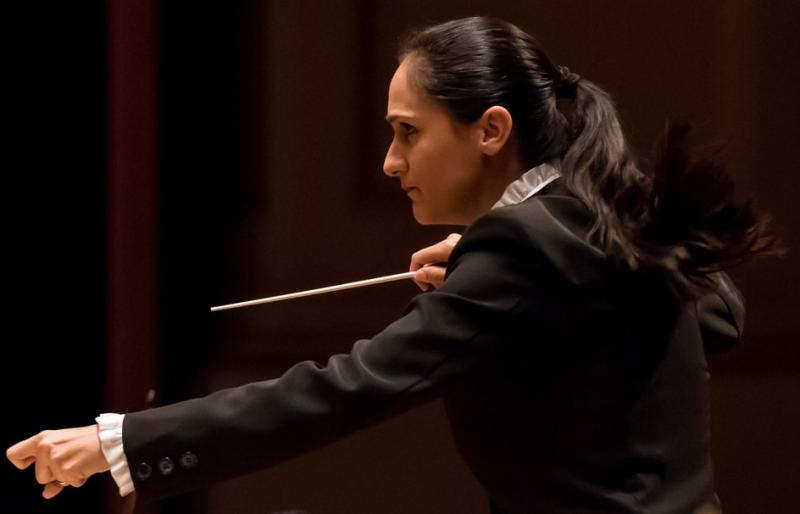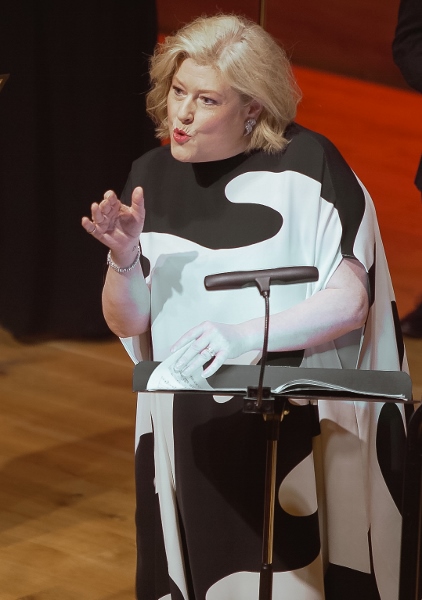Cargill, Kantos Chamber Choir, Manchester Camerata, Menezes, Stoller Hall, Manchester review - imagination and star quality | reviews, news & interviews
Cargill, Kantos Chamber Choir, Manchester Camerata, Menezes, Stoller Hall, Manchester review - imagination and star quality
Cargill, Kantos Chamber Choir, Manchester Camerata, Menezes, Stoller Hall, Manchester review - imagination and star quality
Choral-orchestral collaboration is set for great things

Brazil-born conductor Simone Menezes, known for imaginative and pioneering concert presentation, presided over a striking and illuminating programme shared by Manchester’s Kantos Chamber Choir and Manchester Camerata, with the star quality of Karen Cargill the icing on the cake.
The association between the youthful choir (founded and directed by Ellie Slorach) and orchestra is still relatively new but looks set to lead to great things. In this case there was an intriguing link between several of the pieces on offer and an understated but carefully realised staging: an assembly of unlit candles at the front of the stage, dimmed lighting, some processional movement for the choir – we were invited into a world of memorial and solemnity.
Instead of opening with short pieces in separation, Menezes presented the first three of them in segue: the linking idea of a tolling bell (scored by Arvo Pärt as the opening of his Cantus in Memoriam Benjamin Britten) used first to presage Purcell’s eight-part Hear My Prayer anthem and then Pärt’s Da pacem Domine afterwards. The choir began singing in the gallery above and behind their audience: then moved silently to the main platform as Cantus in Memoriam Benjamin Britten was played, ready for their role in Da pacem Domine.
Their tone quality and tuning are remarkable, exemplifying the best mixed choir singing likely to be heard anywhere, and the Camerata strings, led by Caroline Pether, were a blended, sonorous body capable of a dynamic range from a tiny whisper to a rich tutti.
 That tolling tubular bell was heard again in Britten’s Phaedra, with Karen Cargill (pictured right by Jan Cipriani) the soloist. Officially a “dramatic cantata” for mezzo-soprano and strings plus percussion and harpsichord (with obeisance to the baroque structure of recitative and more free-ranging structure following), it’s been described as a mini-opera in its own right, written near the end of the composer’s life – almost contemporaneous with Death in Venice – and first sung by Janet Baker. There are two themes usually observed in the piece, itself based on Racine’s verse drama – one the idea of illicit love and self-revulsion (and in some ways its cry of “I love you! Fool, I love you, I adore you!”, as the protagonist admits to longing for her husband’s own son, lets right out what Aschenbach holds in), and the other Britten’s own intimations of mortality as its final section describes the approach of death from self-poisoning. Karen Cargill is a great dramatic singer but here I think it was the latter that took prominence. Her peerless tone was used more to express pleading in the former section (it is addressed to the husband, after all), and resolution in the latter. The orchestral role was finely played and skilfully paced and controlled by Menezes.
That tolling tubular bell was heard again in Britten’s Phaedra, with Karen Cargill (pictured right by Jan Cipriani) the soloist. Officially a “dramatic cantata” for mezzo-soprano and strings plus percussion and harpsichord (with obeisance to the baroque structure of recitative and more free-ranging structure following), it’s been described as a mini-opera in its own right, written near the end of the composer’s life – almost contemporaneous with Death in Venice – and first sung by Janet Baker. There are two themes usually observed in the piece, itself based on Racine’s verse drama – one the idea of illicit love and self-revulsion (and in some ways its cry of “I love you! Fool, I love you, I adore you!”, as the protagonist admits to longing for her husband’s own son, lets right out what Aschenbach holds in), and the other Britten’s own intimations of mortality as its final section describes the approach of death from self-poisoning. Karen Cargill is a great dramatic singer but here I think it was the latter that took prominence. Her peerless tone was used more to express pleading in the former section (it is addressed to the husband, after all), and resolution in the latter. The orchestral role was finely played and skilfully paced and controlled by Menezes.
The second part of the concert brought a change of tone, although it had been decided to make a kind of conceptual circle by ending with Karen Cargill singing Dido’s Lament from Purcell’s Dido and Aeneas, followed by “With drooping wings”, the chorus that is its sequel, sung by the choir in procession through the audience.
Before that came Nick Martin’s Falling, a brief, beautiful piece for chorus and strings in which the opening high cello solo (Hannah Roberts) seemed to sing like a human voice, and the textural qualities of both voices and instruments were gorgeously realised – its title hardly needed as its falling interval motif is simply and eloquently employed and repeated.
And then there was Sally Beamish’s Showings, for choir and strings (and that tubular bell again!), which sets texts by Julian of Norwich. Its three sections each have their own title – pity the words were not made available on paper for the audience, as Phaedra’s had been, since the wonderful choral sounds and beautiful harmonies are made to reflect their meaning… though the sustained and ultimately all-embracing middle C symbol of the second section, “The Still Point”, is clear enough.
The Camerata’s one unsung contribution was Michael Tippett’s Fantasia Concertante on a Theme of Corelli, and in truth that seemed a little out of sync with everything else. I suppose you could say it was a kind of In Memoriam (written for Corelli’s tercentenary in 1953), but the main thing about it is that it’s a piece for a virtuoso string orchestra and maybe not an obvious choice for a chamber-sized one. There are, to be unkind, an awful lot of notes, and the Camerata were in control throughout and confident by the time they reached the coda, but the complexity of the counterpoint was at times difficult to appreciate.
rating
Share this article
The future of Arts Journalism
You can stop theartsdesk.com closing!
We urgently need financing to survive. Our fundraising drive has thus far raised £49,000 but we need to reach £100,000 or we will be forced to close. Please contribute here: https://gofund.me/c3f6033d
And if you can forward this information to anyone who might assist, we’d be grateful.

Subscribe to theartsdesk.com
Thank you for continuing to read our work on theartsdesk.com. For unlimited access to every article in its entirety, including our archive of more than 15,000 pieces, we're asking for £5 per month or £40 per year. We feel it's a very good deal, and hope you do too.
To take a subscription now simply click here.
And if you're looking for that extra gift for a friend or family member, why not treat them to a theartsdesk.com gift subscription?
more Classical music
 Echo Vocal Ensemble, Latto, Union Chapel review - eclectic choral programme garlanded with dance
Beautiful singing at the heart of an imaginative and stylistically varied concert
Echo Vocal Ensemble, Latto, Union Chapel review - eclectic choral programme garlanded with dance
Beautiful singing at the heart of an imaginative and stylistically varied concert
 Scott, Irish Baroque Orchestra, Whelan, RIAM, Dublin review - towards a Mozart masterpiece
Characteristic joy and enlightenment from this team, but a valveless horn brings problems
Scott, Irish Baroque Orchestra, Whelan, RIAM, Dublin review - towards a Mozart masterpiece
Characteristic joy and enlightenment from this team, but a valveless horn brings problems
 Classical CDs: Voice flutes, flugelhorns and froth
Baroque sonatas, English orchestral music and an emotionally-charged vocal recital
Classical CDs: Voice flutes, flugelhorns and froth
Baroque sonatas, English orchestral music and an emotionally-charged vocal recital
 Kanneh-Mason, Britten Sinfonia, Shave, Milton Court - a grin and a big beaming smile
A pair of striking contemporary pieces alongside two old favourites
Kanneh-Mason, Britten Sinfonia, Shave, Milton Court - a grin and a big beaming smile
A pair of striking contemporary pieces alongside two old favourites
 theartsdesk at the New Ross Piano Festival - Finghin Collins’ musical rainbow
From revelatory Bach played with astounding maturity by a 22 year old to four-hand jazz
theartsdesk at the New Ross Piano Festival - Finghin Collins’ musical rainbow
From revelatory Bach played with astounding maturity by a 22 year old to four-hand jazz
 First Person: Manchester Camerata's Head of Artistic Planning Clara Marshall Cawley on questioning the status quo
Five days of free events with all sorts of audiences around Manchester starts tomorrow
First Person: Manchester Camerata's Head of Artistic Planning Clara Marshall Cawley on questioning the status quo
Five days of free events with all sorts of audiences around Manchester starts tomorrow
 Goldscheider, Brother Tree Sound, Kings Place review - music of hope from a young composer
Unusual combination of horn, strings and electronics makes for some intriguing listening
Goldscheider, Brother Tree Sound, Kings Place review - music of hope from a young composer
Unusual combination of horn, strings and electronics makes for some intriguing listening
 theartsdesk Q&A: composer Donghoon Shin on his new concerto for pianist Seong-Jin Cho
Classical music makes its debut at London's K-Music Festival
theartsdesk Q&A: composer Donghoon Shin on his new concerto for pianist Seong-Jin Cho
Classical music makes its debut at London's K-Music Festival
 Helleur-Simcock, Hallé, Wong, Bridgewater Hall, Manchester review - moving lyricism in Elgar’s concerto
Season opener brings lyrical beauty, crisp confidence and a proper Romantic wallow
Helleur-Simcock, Hallé, Wong, Bridgewater Hall, Manchester review - moving lyricism in Elgar’s concerto
Season opener brings lyrical beauty, crisp confidence and a proper Romantic wallow
 Kohout, Spence, Braun, Manchester Camerata, Huth, RNCM, Manchester review - joy, insight, imagination and unanimity
Celebration of the past with stars of the future at the Royal Northern College
Kohout, Spence, Braun, Manchester Camerata, Huth, RNCM, Manchester review - joy, insight, imagination and unanimity
Celebration of the past with stars of the future at the Royal Northern College

Add comment